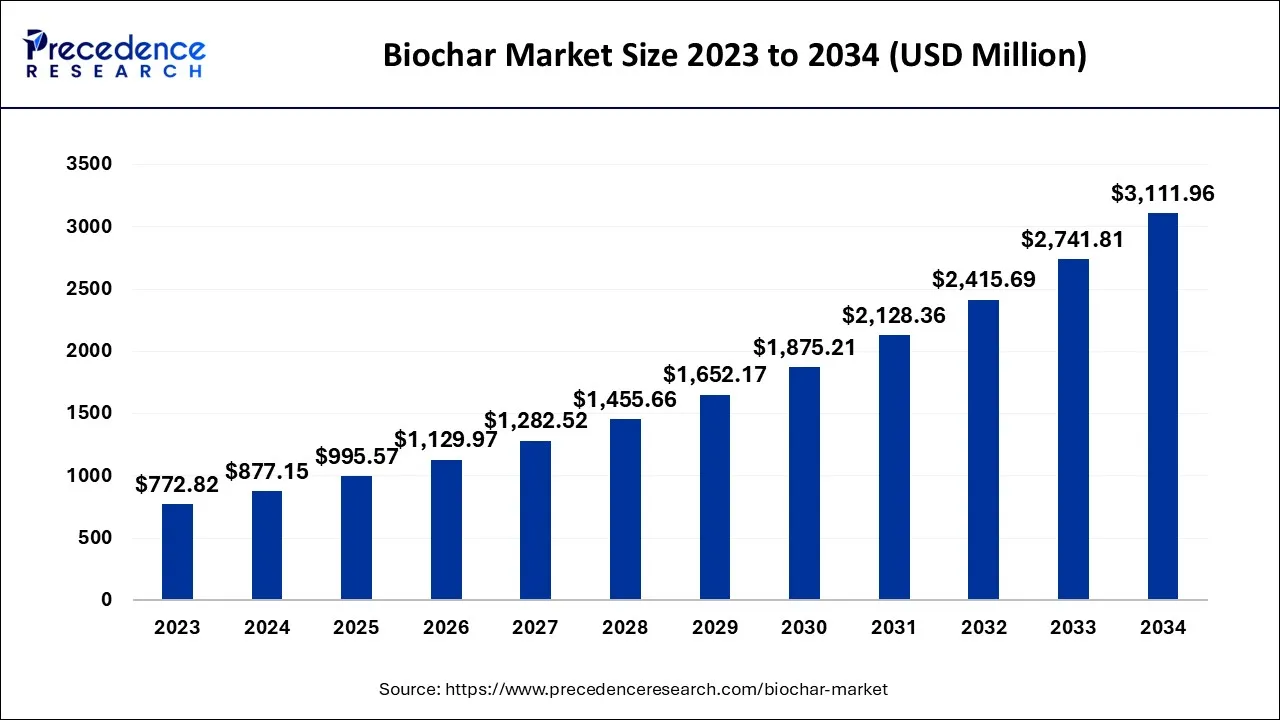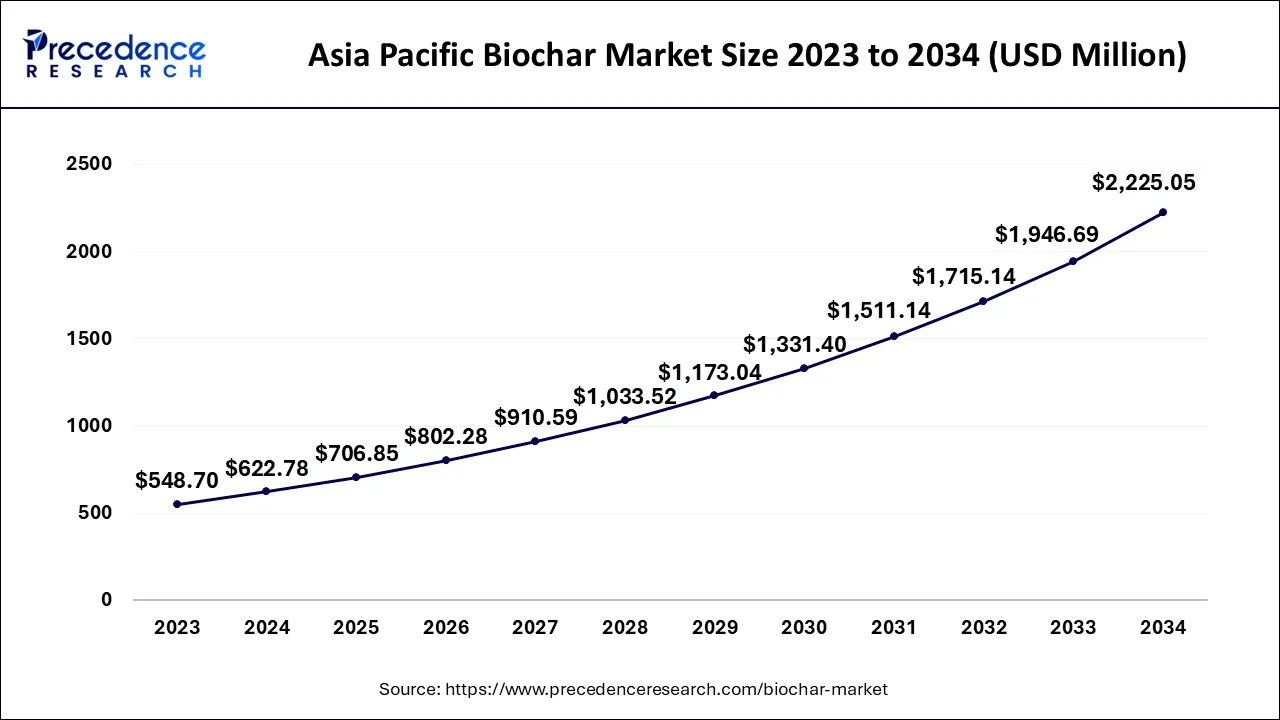The global biochar market size accounted for USD 877.15 million in 2024, grew to USD 995.57 million in 2025, and is expected to be worth around USD 3,111.96 million by 2034, poised to grow at a CAGR of 13.5% between 2024 and 2034. The Asia Pacific biochar market size is predicted to increase from USD 6.88 million in 2024 and is estimated to grow at the fastest CAGR of 10.32% during the forecast year.
The global biochar market size is expected to be valued at USD 877.15 million in 2024 and is anticipated to reach around USD 3,111.96 million by 2034, expanding at a CAGR of 13.5% over the forecast period from 2024 to 2034. The rising importance of biochar to increase soil porosity and reduce soil water loss is considered to boost the demand for biochar in the global market.

The Asia Pacific biochar market size is exhibited at USD 622.78 million in 2024 and is projected to be worth around USD 2,225.05 million by 2034, growing at a CAGR of 13.58% from 2024 to 2034.

Geographically, Asia Pacific dominates the global biochar market, and it is projected to grow at a significant rate during the estimated period. The rapid increase in the agricultural sector in countries such as India and China has boosted the growth of the biochar market in the region. Rising research and development activities in the region to produce biochar products in order to boost crop yield are seen as major drivers for the development of the biochar market.
North America is the second-largest market for biochar products. Rising awareness for organic food products acts as a driver for the growth of the biochar market in North America. Europe is expected to witness a shift during the forecast period. Strict environmental standards for agricultural activities have boosted the demand for biochar in the region.

Moreover, large-scale companies in major European countries have propelled the market's growth. Furthermore, factors such as rising investments in research and development (R&D) activities and new product launches are anticipated to boost the growth of the European biochar market.
Brazil and Mexico are the most significant contributors to the expansion of the biochar market in Latin America. Several governments in Latin America are focused on implementing standards to reduce greenhouse carbon emissions; this is projected to boost the demand for biochar from various industries. However, the pace of market growth is steady in the Middle East and Africa.
Biochar is a carbon-rich product made from biomass. Biochar is a porous form of charcoal that is widely used to improve the quality of the soil. Considered a future of sustainable agriculture, biochar carries enormous benefits for soil and the ecosystem. Biochar is a natural fertilizer used as a soil amendment. Biochar has been helping the earth by increasing its physical, chemical, and biological properties.
The biochar is made with pyrolysis technology by heating the biomass to form a charcoal-like substance. Later, this biochar is mixed with compost or vermicompost before it enters the soil. The world is facing multiple challenges, be it climate change, rapidly increasing population, or rising pollution. Biochar is believed to slow down the release of hazardous greenhouse gases from the soil. Which apparently helps in reducing CO2 from the atmosphere.
The utilization of biochar is considered to ease farming by reducing the use of chemicals and welcoming organic products into the market. Along with the reduced emissions of carbon, biochar also offers carbon sequestration, reduced soil acidity and increased water retention for soil.
| Report Coverage | Details |
| Market Size in 2024 | USD 877.15 Million |
| Market Size by 2034 | USD 3,111.96 Million |
| Growth Rate from 2024 to 2034 | CAGR of 13.5% |
| Largest Market | Asia Pacific |
| Second Largest Market | North America |
| Base Year | 2023 |
| Forecast Period | 2024 to 2034 |
| Segments Covered | By Technology, By Feedstock and By Application |
| Regions Covered | North America, Europe, Asia-Pacific, Latin America and Middle East & Africa |
The global biochar market is anticipated to witness a significant increase during the estimated period of 2024-2034. Rising investment in the agricultural sector by governments is considered the primary driver for the growth of the biochar market. Increasing awareness for global organic yet environmentally friendly products due to rising environmental concerns is another driver for the market’s growth.
The rising importance of renewable energy has boosted the utilization of biochar in energy production industries; the demand is expected to grow in the coming years. Biochar is also considered a sustainable source to manage food security, energy security and climate change. Many governments are focused on implementing regulatory policies to reduce carbon emissions through agricultural activities; this factor will fuel the growth of the biochar market.
Other factors such as rising research and development (R&D) activities, new product launches, rising international trading of agricultural bio-products, and easy availability of feedstock are considered drivers for the growth of the global biochar market.
However, the high production cost of biochar acts as a restraining factor for the market’s growth. Biochar production takes longer to be prepared than chemical fertilizers; this factor is seen as another restraining factor for the market. Lack of awareness about biochar in the market is another factor hindering the growth of the global biochar market. Easy availability of chemical fertilizers in the market, quality control, lack of investment, and side effects caused by the overuse of biochar are a few other factors that hamper the market's growth.
Based on technology, the pyrolysis segment dominates the global biochar market and is expected to maintain growth during the forecast period. Pyrolysis is the process of converting biomass to form biochar at a particular temperature range. Pyrolysis is the most effective and widely used process for creating biochar under oxygen-deprived conditions, as it can potentially convert any biomass into biochar.
The pyrolysis technology is preferred for forming biochar as it offers multiple economic and environmental benefits. The pyrolysis process is further segmented into slow, moderate, and fast pyrolysis. However, fast pyrolysis at the elevated temperature of 500°C is considered the ideal state for biochar formation.
However, the gasification segment is estimated to witness a significant increase in the upcoming year owing to the continuous advancement in gasification technology. The gasification process partially combusts biomass/biowaste to produce high-quality biochar. This thermal conversion process was initially developed for converting coal. In recent years, agriculture started using this technology for biochar production.
Based on feedstock, the agricultural waste segment dominates the global biochar market. The agricultural waste segment comprises corncob, oil palm shells, coconut shells, palm fronds, palm leaves, bamboo, rice straw, cassava rhizomes, and rice husk for biochar production. This method is primarily used in underdeveloped or economically weaker countries due to its easy availability and affordability. Later, the efficiency of these agricultural wastes is induced by the pyrolysis process.
On the other hand, the animal manure segment is predicted to dominate the market in the upcoming years. Sheep, cow, or chicken manure are considered to be the best animal manure for the production of biochar. Animal excrement carries high nutritional value and acts as a soil conditioner. Rising demand for environmentally friendly products has boosted the animal manure segment recently.
The utilization of cattle manure in biochar reduces the need for fertilizers at the time of cultivation, it is also considered a natural fertilizer. The rising demand for animal manure is attributed to the fact that it can retain nutrients in the soil for years by maintaining the quality of the soil.
Based on application, the agriculture segment acquires the largest revenue share in the global biochar market. Biochar is considered a natural fertilizer for enhancing the quality of the soil. Rising awareness about the side effects of chemical fertilizers and pesticides on the environment and crops is boosting the importance of biochar for agricultural activities.
Utilization of biochar offers enhanced crop productivity, bulk density, biological nitration fixation, maintained soil moisture and multiple other benefits. Considering these potential benefits provided by biochar to the soil, the agriculture segment is predicted to grow during the estimated period. In the agricultural sector, plant-based biochar is also preferred as an excellent supplement for animals (cattle). It offers proper nutritional value to improve blood levels, and digestion and remove toxins from the body.
Another segment, electricity generation, is expected to grow at a significant rate. Biochar is seen as a renewable resource for electricity generation. Rising awareness for green energy due to rising environmental concerns is expected to boost the electricity generation segment in the global biochar market. Rising carbon emissions are prone to increase the utilization of biochar in forestry.
The soil in forests tends to lose its prosperity due to wildfires, deforestation and many other reasons. The utilization of biochar as a soil amendment can restore soil quality by improving the fertility of the soil. However, the cost and efforts for implementing biochar as a soil amendment in forests are likely to hinder the growth of the forestry segment.
By Technology
By Feedstock
By Application
By Geography
For inquiries regarding discounts, bulk purchases, or customization requests, please contact us at sales@precedenceresearch.com
No cookie-cutter, only authentic analysis – take the 1st step to become a Precedence Research client